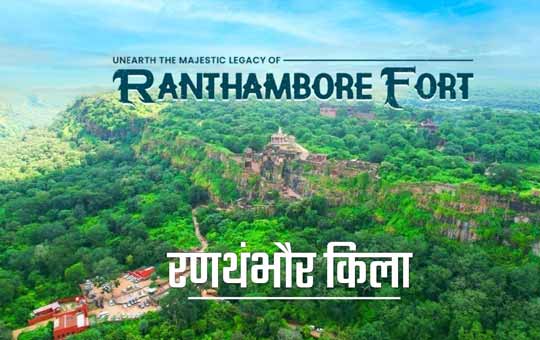Ranthambore Fort: A Majestic Testament to Rajasthan’s Glorious Past
Ranthambore Fort, perched atop a rugged hill in the Sawai Madhopur district of Rajasthan, is a formidable symbol of Rajput valor and architectural brilliance. Overlooking the famous Ranthambore National Park, the fort is an extraordinary blend of history, culture, and nature. This UNESCO World Heritage Site is one of the most significant forts in India, narrating tales of bravery, strategic conquests, and the undying spirit of its rulers.
Ranthambore Fort History
During the Second Battle of Tarain in 1192 CE, Prithviraj Chauhan was defeated by the Ghurids and the fort was captured by Muhammad Ghori. In 1226, the fort was captured by the Sultan of Delhi – Iltutmish. After his death in 1236, Ranthambore Fort was recaptured by the Chauhans. And in 1301, the Sultan of Delhi – Alauddin Khilji, captured the fort and ended the reign of the Chauhan Dynasty.
Later, the fort was captured by the Mewar rulers, and then the Hada rulers. In 1568, it was captured by the Mughal Emperor – Akbar. It stayed under the control of the Mughal rulers till the end of the 18th century. After that, it was returned to the King of Jaipur till India gained independence in 1947.
Architectural Marvel
Ranthambore Fort is a striking example of Rajput military architecture, designed to withstand sieges and attacks. Situated at an altitude of approximately 700 feet above sea level, the fort provides a panoramic view of the surrounding forest and wildlife.
The fort is protected by massive stone walls, bastions, and seven strategically placed gates:
- Navlakha Pol
- Hathi Pol
- Ganesh Pol
- Andheri Pol
- Sat Pol
- Suraj Pol
- Delhi Pol
These gates were designed to make enemy advancement difficult. Within the fort, remnants of palaces, temples, stepwells, and reservoirs reflect the architectural prowess of the bygone era. The intricate carvings, massive domes, and elaborate structures still stand as testimony to the artistic finesse of the Rajputs.
Major Attractions Inside the Fort
1. Trinetra Ganesh Temple
One of the most revered shrines within the fort is the Trinetra Ganesh Temple, dedicated to Lord Ganesha. It is believed that this temple was established in 1299 after King Hammir Dev Chauhan received a divine vision of Lord Ganesh. Devotees from across India visit the temple to seek blessings, and it remains an integral part of Ranthambore’s cultural heritage.
2. Hammir Palace and Badal Mahal
The Hammir Palace, once a grand royal residence, showcases Rajput architectural excellence. The Badal Mahal (Cloud Palace) served as a royal retreat and is known for its picturesque setting and elaborate design.
3. Jogi Mahal
Located near the fort, Jogi Mahal is famous for housing one of the largest banyan trees in India. This structure was once used as a rest house for visitors but now remains a historical landmark.
4. Rajput and Mughal Influence
Several pavilions, mosques, and tombs scattered throughout the fort highlight the blend of Rajput and Mughal architectural influences. The fort’s history of being ruled by different dynasties is evident in its design and construction techniques.
Ranthambore Fort and the National Park
The fort’s location within Ranthambore National Park adds a unique aspect to its appeal. Visitors often spot wildlife such as leopards, sambar deer, and even the elusive Bengal tiger while exploring the fort. The fort’s integration with nature makes it a rare historical site where heritage and wildlife coexist harmoniously.
Cultural and Spiritual Importance
Apart from its military significance, Ranthambore Fort holds deep religious and cultural value. Festivals and rituals at the Trinetra Ganesh Temple are major events, drawing thousands of pilgrims every year. The fort’s association with Rajasthan’s folk tales and local legends also adds to its mystique.
Best Time to Visit and How to Reach
Best Time to Visit
The ideal time to visit Ranthambore Fort is between October and March, when the weather is pleasant, making exploration comfortable. Summers can be extremely hot, while monsoons bring occasional showers that enhance the fort’s scenic beauty.
How to Reach
- By Air: The nearest airport is in Jaipur, approximately 160 km away.
- By Train: Sawai Madhopur Railway Station, around 13 km from the fort, is well-connected to major cities.
- By Road: Regular buses, taxis, and private vehicles can be hired from Jaipur and nearby cities.
Preservation and UNESCO Recognition
Ranthambore Fort, along with other hill forts of Rajasthan, was inscribed as a UNESCO World Heritage Site in 2013 under the category of “Hill Forts of Rajasthan.” Conservation efforts are ongoing to preserve its historical structures and ensure that its rich legacy remains intact for future generations.
